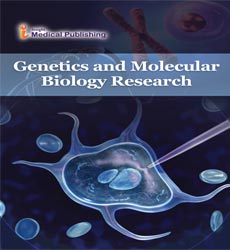An Overview on Nucleotides
Mohammed Kabeer*
Department of Biotechnology, Bhaskar Medical College, India
- Corresponding Author:
- Mohammed Kabeer
Department of Biotechnology, Bhaskar Medical College, India
E-mail: kabeerm052@gmail.com
Received Date: May 08, 2021; Accepted Date: May 17, 2021; Published Date: June 10, 2021
Citation: Kabeer M (2021) An Overview on Nucleotides: Commentary. Genet Mol Biol Res Vol No: 5 Iss No: 3:47
Copyright: © 2021 Kabeer M. This is an open-access article distributed under the terms of the Creative Commons Attributions License, which permits unrestricted use, distribution and reproduction in any medium, provided the original author and source are credited.
In DNA and RNA, nucleotides are covalently linked by the phosphate group; the charge of the phosphate group at neutral pH is important for stabilizing nucleotides against hydrolysis and for retaining them within a lipid membrane. Differences within the nitrogenous base determine the basic and functional variation among nucleotides.
Nucleotides, as they seem in RNA, contain on the average 36.2% C, 16% N, and 9.6% P; the basic composition of nucleotides in DNA is extremely similar. Thus, nucleotides in nucleic acids have N levels that are almost like those found in protein (16% vs. 17%), which are successively much above levels in most organisms. The P content of a mean nucleotide is additionally an order of magnitude above the P content of most insects, marine invertebrates, and plants. RNA can comprise an outsized, but variable fraction of organism biomass. for instance, RNA content can range from 12% to 30% of cell dry mass.
DNA levels are known to be much less than RNA levels in most organisms. Genome size varies by up to 5 orders of magnitude among taxa, but this variation is amid corresponding changes in cell size. As a result, DNA levels as a fraction of cellular biomass appear to be quite consistent across organisms and thus likely explain little or no of the variation in C: N:P stoichiometry among taxa.
ATP may be a nucleoside that is widely used for transporting energy in cells. An ATP molecule contains 24% C, 14% N, and 18% P: it is thus even more P-rich than the nucleotides in macromolecule. However, ATP generally makes up only a little fraction of the entire biomass of most organisms. for instance, ATP levels range from 0.3% to 1.8% dry mass in marine copepods, and from only 0.02% to twenty dry mass in insects. As a result, variation in ATP content is unlikely to elucidate much of the variation among organisms in sC:N:P stoichiometry. A nucleotide consists of a nitrogenous base pentose-phosphate.
When the sugar is ribose, a nucleotide may be a ribonucleotide and is employed for the biosynthesis of RNA.
Similarly, when the sugar is deoxyribose, a nucleotide may be a deoxyribonucleotide and is employed for the biosynthesis of DNA.
Ribonucleotides and deoxyribonucleotides that have adenine or guanine because the nitrogenous base are purine nucleotides. people who have cytosine, thymine, or uracil because the nitrogenous base are pyrimidine nucleotides.
These could also be transitions (purine to purine or pyrimidine to pyrimidine: G–T or A–C) or transversions (purine to pyrimidine or pyrimidine to purine: C–C, T–T, C–T; A–A, G–G, A–G). for instance, in post replication ‘repair’, a DNA damage tolerance mechanism that leaves a niche in response to replication on a damaged template, the polymerase always inserts an adenine within the gap. additionally, deamination of cytosine leads to thymidine.
Both NER and MMR feature degradation of a comparatively large portion of the damaged strand, followed by 5′ to 3′ patch synthesis using the undamaged strand as a template, and ligation to finish the repair. The DNA mismatch is recognized by a repair protein complex (either MSH1–MSH2–MSH6–PMS1 or MSH1–MSH2–MSH6–PMS2) that simultaneously anchors to both the mismatch and therefore the closest unmethylated adenine within the GATC recognition sequence.
The whole sequence between the mismatch and therefore the GATC recognition sequence is eroded, and PCNA is recruited to act as a sliding clamp and support the action of a DNA polymerase (polΔ or polε) in replication of the repair patch. A ligase (DNA ligase I) subsequently complexes with polymerase (polΔ) to finish the repair function.
Mismatch DNA repair is critical within the maintenance of a stable genome. Somatic mutations in these genes can also contribute to the mutator phenotype.
Open Access Journals
- Aquaculture & Veterinary Science
- Chemistry & Chemical Sciences
- Clinical Sciences
- Engineering
- General Science
- Genetics & Molecular Biology
- Health Care & Nursing
- Immunology & Microbiology
- Materials Science
- Mathematics & Physics
- Medical Sciences
- Neurology & Psychiatry
- Oncology & Cancer Science
- Pharmaceutical Sciences
